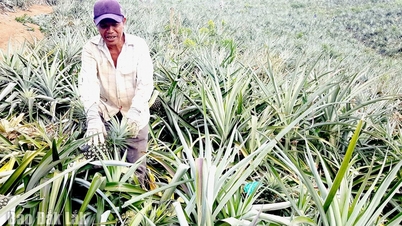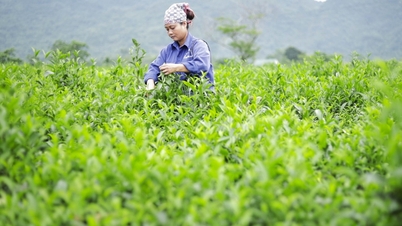In Cam Lam district, peeling and slicing mangoes for making dried mangoes and mango rice paper snacks requires diligence, meticulousness, and skill. This seasonal work has helped some laborers earn extra income during the agricultural off-season.
It requires diligence, perseverance, and meticulousness.
Arriving at the Khanh Vu dried mango factory (Dai Han Street, Cam Duc town), we saw the factory workers busily peeling and slicing mangoes to make dried mangoes. Each month, the factory imports about 3 to 4 shipments, each containing around 15 tons of various types of mangoes. The factory needs about 20 people to peel and slice this amount of mangoes within two days, ensuring they don't overripe. Therefore, in addition to the 8 current workers, the factory also hires seasonal laborers. While working and chatting, Ms. Tran Thi Anh Ngoc (born in 1977, Lam Son village, Cam Thanh Bac commune) said that this job requires diligence, meticulousness, hard work, perseverance, and skill, so it is mostly done by women. "When I first started, I also faced difficulties. It looks simple, but to peel beautifully and cut quickly requires a lot of practice. Continuously peeling and slicing can lead to pain and swelling in the hands; mango sap causes itching and allergic reactions. Therefore, everyone is slow when they first start, and only get used to it over time," Ms. Ngoc shared.
 |
| Peeling and slicing require patience and meticulousness, so it is mostly done by women. |
After the mangoes are destemmed, workers peel them. Skilled hands quickly peel the mangoes, resulting in smooth, glossy slices. Then, the mangoes are sliced. Workers say that initially, they used straight knives, which resulted in uneven slices. Later, they learned and experimented, creating a curved knife to produce beautiful slices. This process also requires the worker's hand to maintain balance while holding the mango. Ms. Le Thi Hong (born in 1984, Trung Hiep 2 village, Cam Hiep Bac commune) explains that for the mangoes to look smooth and beautiful after peeling, the cuts must be continuous. During the slicing process, overripe or damaged mango pieces are removed. Mangoes used for dried mangoes must be just ripe, soft to the touch but still firm. After peeling and slicing, the mangoes are washed, rinsed to remove excess acidity, mixed with sugar, and then placed on drying racks.
At the Cam Lam mango rice paper production factory of Mango Cat Tien Co., Ltd., workers peel ripe mangoes to prepare the ingredients for making mango rice paper. Ms. Le Thi Thu Thuy (born in 1970, Bac Vinh village, Cam Hai Tay commune) said that the mangoes used for making mango rice paper are mainly Canh Nong mangoes, with a small amount of Australian and Taiwanese mangoes. Canh Nong mangoes, when ripe, have soft skins that are easier to peel than other types of mangoes; workers use a knife to cut the stem, then use a knife to pull the peel along the mango's body. For Australian and Taiwanese mangoes, because the skins are thicker, peeling takes longer and they must be sliced before being ground. After that, the mangoes are cooked and then used to make the rice paper. The work also requires diligence and meticulousness.
 |
| Female workers are packaging mango rice paper snacks. |
Earn extra income during the off-season for farming.
According to Ms. Ngoc, the job of peeling and slicing mangoes for making dried mangoes is paid per product at 1,600 VND/kg; on average, she peels about 300kg of mangoes a day, earning about 480,000 VND. This job brings in an income of 300,000 to 500,000 VND/day/person, and if peeling faster, it can earn 700,000 to 800,000 VND/day. However, because it is seasonal work, it is not regular, only working a few days each month. On the remaining days, the factory workers perform other tasks, such as: placing mangoes on drying racks, taking the goods down from the racks after drying, drying mangoes in the cold room, gathering mangoes, packaging... with an income of 4 to 5 million VND/person/month. Ms. Hong said that when mangoes are in season, the work of peeling and slicing mangoes is more frequent, about 8 to 9 days/month. If there are a lot of mangoes, she peels an average of 300 to 400 kg per day. “Working near home, in a cool place, and with flexible hours, I’ve been doing this job for two years. Besides peeling mangoes, I also do other tasks at the factory,” Ms. Hong said.
Mr. Tran Le Hoa (born in 1994), Director of Cat Tien Mango Co., Ltd., said: “Each month, the factory imports about 100 tons of mangoes to make cakes. The job of peeling mangoes is paid daily at a rate of 220,000 to 250,000 VND/day. In addition to the on-site workers, the factory also has to hire 10 seasonal workers. During the off-season, laborers can earn extra income from this job.”
CHAU TUONG
Source


![[Image] Leaked images ahead of the 2025 Community Action Awards gala.](/_next/image?url=https%3A%2F%2Fvphoto.vietnam.vn%2Fthumb%2F1200x675%2Fvietnam%2Fresource%2FIMAGE%2F2025%2F12%2F16%2F1765882828720_ndo_br_thiet-ke-chua-co-ten-45-png.webp&w=3840&q=75)
![[Photo] Prime Minister Pham Minh Chinh receives Lao Minister of Education and Sports Thongsalith Mangnormek](/_next/image?url=https%3A%2F%2Fvphoto.vietnam.vn%2Fthumb%2F1200x675%2Fvietnam%2Fresource%2FIMAGE%2F2025%2F12%2F16%2F1765876834721_dsc-7519-jpg.webp&w=3840&q=75)
![[Photo] Prime Minister Pham Minh Chinh receives the Governor of Tochigi Province (Japan)](/_next/image?url=https%3A%2F%2Fvphoto.vietnam.vn%2Fthumb%2F1200x675%2Fvietnam%2Fresource%2FIMAGE%2F2025%2F12%2F16%2F1765892133176_dsc-8082-6425-jpg.webp&w=3840&q=75)
![[Live] 2025 Community Action Awards Gala](/_next/image?url=https%3A%2F%2Fvphoto.vietnam.vn%2Fthumb%2F1200x675%2Fvietnam%2Fresource%2FIMAGE%2F2025%2F12%2F16%2F1765899631650_ndo_tr_z7334013144784-9f9fe10a6d63584c85aff40f2957c250-jpg.webp&w=3840&q=75)

![[Image] The tenacious fighting spirit of Vietnamese women's football](/_next/image?url=https%3A%2F%2Fvphoto.vietnam.vn%2Fthumb%2F1200x675%2Fvietnam%2Fresource%2FIMAGE%2F2025%2F12%2F17%2F1765990260956_ndo_br_4224760955870434771-copy-jpg.webp&w=3840&q=75)











































































![[Live] Closing Ceremony and Award Presentation for the "Impressive Vietnam Tourism" Video/Clip Creation Contest 2025](https://vphoto.vietnam.vn/thumb/402x226/vietnam/resource/IMAGE/2025/12/17/1765974650260_z7273498850699-00d2fd6b0972cb39494cfa2559bf85ac-1765959338756946072104-627-0-1338-1138-crop-1765959347256801551121.jpeg)



















Comment (0)